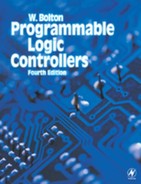0%
22Chapters
0-1Hours read
0kTotal Words
Book Description
This is the introduction to PLCs for which baffled students, technicians and managers have been waiting. In this straightforward, easy-to-read guide, Bill Bolton has kept the jargon to a minimum, considered all the programming methods in the standard IEC 1131-3 - in particular ladder programming, and presented the subject in a way that is not device specific to ensure maximum applicability to courses in electronics and control systems.Now in its fourth edition, this best-selling text has been expanded with increased coverage of industrial systems and PLCs and more consideration has been given to IEC 1131-3 and all the programming methods in the standard. The new edition brings the book fully up to date with the current developments in PLCs, describing new and important applications such as PLC use in communications (e.g. Ethernet – an extremely popular system), and safety – in particular proprietary emergency stop relays (now appearing in practically every PLC based system).
The coverage of commonly used PLCs has been increased, including the ever popular Allen Bradley PLCs, making this book an essential source of information both for professionals wishing to update their knowledge, as well as students who require a straight forward introduction to this area of control engineering.
Having read this book, readers will be able to:
* Identify the main design characteristics and internal architecture of PLCs
* Describe and identify the characteristics of commonly used input and output devices
* Explain the processing of inputs and outputs of PLCs
* Describe communication links involved with control systems
* Develop ladder programs for the logic functions AND, OR, NOT, NAND, NOT and XOR
* Develop functional block, instruction list, structured text and sequential function chart programs
* Develop programs using internal relays, timers, counters, shift registers, sequencers and data handling
* Identify safety issues with PLC systems
* Identify methods used for fault diagnosis, testing and debugging programs
Fully matched to the requirements of BTEC Higher Nationals, students are able to check their learning and understanding as they work through the text using the Problems section at the end of each chapter. Complete answers are provided in the back of the book.
* Thoroughly practical introduction to PLC use and application - not device specific, ensuring relevance to a wide range of courses
* New edition expanded with increased coverage of IEC 1131-3, industrial control scenarios and communications - an important aspect of PLC use
* Problems included at the end of each chapter, with a complete set of answers given at the back of the book
Table of Contents
- Cover
- Title Page
- Copyright
- Table of Contents
- Preface
- Chapter 1: Programmable logic controllers
- Chapter 2: Input—output devices
- Chapter 3: Number systems
- Chapter 4: I/O processing
- Chapter 5: Ladder and functional block programming
- Chapter 6: IL, SFC and ST programming methods
- Chapter 7: Internal relays
- Chapter 8: Jump and call
- Chapter 9: Timers
- Chapter 10: Counters
- Chapter 11: Shift registers
- Chapter 12: Data handling
- Chapter 13: Designing systems
- Chapter 14: Programs
- Symbols
- Answers
- Index
